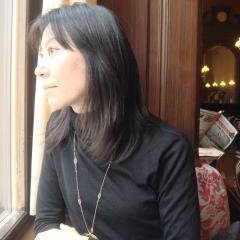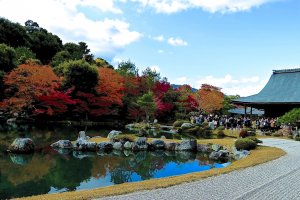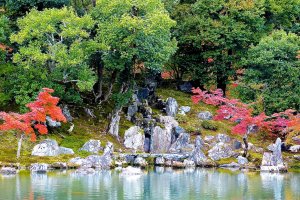Autumn is the season in Kyoto when everything becomes peaceful and calm: Clear skies, colorful leaves, and perfect weather. It is my favorite time of the year. And here, in Arashiyama, I think about how much Kyoto's noble elite and Buddhist priests enjoyed this beautiful garden for 700 years. And now we can enjoy it, too!
In Kyoto's Arashiyama district, the landscape of cherry blossoms and autumn leaves are very special in the spring and autumn, but this area of the city attracts people throughout the year. Tenryu-ji Temple in Arashiyama, registered as a World Heritage Site, has a beautiful garden, with Arashiyama and Kameyama mountains behind the garden. The great Zen master, Priest Muso Soseki, designed this garden in 1345, based on his Zen philosophy.
Walking route
There are two entrances in front of the Main hall: The Main hall entrance (right side) and the Garden entrance (left side). Go in through the Garden entrance. Walk around the outside of the main hall, enjoying the sand garden. This is the garden Muso Soseki designed - the Hojo Garden. There is also a pond here. However, there are no places to sit and meditate. If you are interested, there is a beautiful green garden behind the Main hall - the Hyakka-en Garden.
Hojo Garden
Kyoto has many dry gardens that abstractly express various forms of water in nature by using rocks and sand. Tenryu-ji’s beautiful garden is not a simple dry garden, but a perfect fusion of three key elements. 1) White sand arranged in a pattern of gentle waves, representing typical Japanese waters. 2) Rocks and stones arranged around a pond, representing the rough coastline of China. 3) The views of Mt. Arashiyama and Mt. Kameyama in the background. The fascinating color contrast of blue sky, clear pond, and red, yellow, orange and green leaves is splendid in late November.
Priest Muso Soseki and his approach to gardening
Before this garden, there were no such well-designed dry gardens in Japan. People in the old days usually copied famous nice views and pasted in their gardens. They made ponds and islands and sailing ships, and it felt like you were traveling somewhere else. The distinctive point behind the design of this garden is that the designer, Muso Soseki, was a prominent Zen master. He built gardens for the practice of Zen.
Muso Soseki wandered around Kyoto, Kamakura, Nasu, Tohoku, and other places, eagerly learning Buddhist teachings until he was 50 years old. During his travels, he probably enjoyed many nice scenes in many places. He thought he should put himself into the universality of nature and devote himself to Zen practice. But he also thought there should be appropriate surroundings for the practice. And so he started to plan gardens. His experience of Zen in nature had a great impact on the way he planned his gardens.
For example, Zen priests practice meditation to attain the state of nothingness. But it is not an easy thing to do. Zen says that we can practice Zen meditation anywhere and everywhere. It means we can practice in a room, on a rock, and also in a garden. So, Muso Soseki built special gardens for the purpose of meditation. In addition to Tenryu-ji’s garden, Muso Soseki made full use of this philosophy in the gardens of Saiho-ji (Kyoto) and Zuisen-ji (Kamakura).


































